The army of Manchukuu: how the Japanese created the second “Manchu empire” and its armed forces
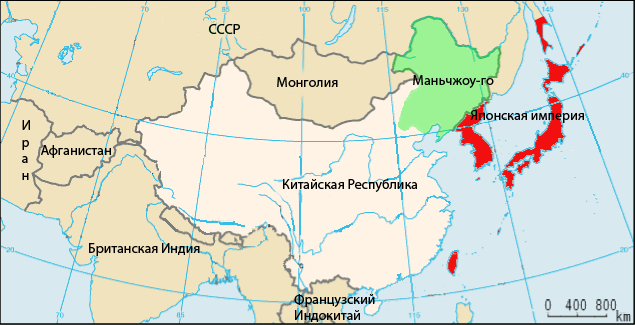
For a long time, the Manchu ethnocracy in China prevented the Chinese from penetrating into the territory of their historic homeland, Manchuria, in an effort to preserve the ethnic separateness and identity of the latter. However, after Russia annexed a part of the land, called Outer Manchuria (now Primorsky Krai, Amur Oblast, Jewish Autonomous Oblast), the Qing emperors from the absence of other options to preserve Inner Manchuria from the gradual absorption of the Russian empire began to settle the region with the Chinese . As a result, the population in Manchuria has increased dramatically. Nevertheless, by the end of the 19th century, it became obvious that the region was of interest for the two neighboring states, which significantly surpass the weakened and archaic Qing empire in economic and military potential - for the Russian Empire and for Japan. In 1896, construction began on the Chinese-Eastern Railway, in 1898, Russia rented the Liaodong Peninsula from China, and in 1900, in the course of counteracting the Boxer uprising, Russian troops occupied part of Manchuria. The refusal of the Russian Empire to withdraw troops from Manchuria was one of the key reasons for the Russian-Japanese war of 1904-1905. The defeat in this war of Russia led to the actual establishment of Japanese control over Manchuria.
Creation of Manchukuo and Emperor Pu Yi
Japan, in an effort to prevent Manchuria from returning to the orbit of Russian influence, in every way prevented the reunification of Manchuria with China. Especially actively this opposition began after the overthrow of the imperial Qing dynasty in China. In 1932, Japan decides to legitimize its presence in Manchuria by creating a puppet state entity that would formally be an independent state, and in fact follow completely in the wake of Japanese foreign policy. This state, created on the territory occupied by the Japanese Kwantung Army, was named Damanzhou Digo - the Great Manchurian Empire, also abbreviated as Manchukuo or the State of Manchuria. The capital of the state was located in the city of Xinjing (now Changchun).
At the head of the state, the Japanese put Pu Yi (Manchu name - Aisin Gero) - the last Chinese emperor of the Qing dynasty, who was removed from power in China in 1912 the year after the Xinhai revolution, and in 1924 finally deprived of the imperial title and all the regalia.
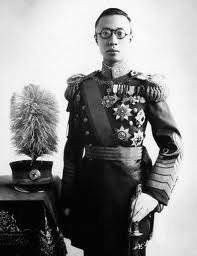 Pu and 1932-1934's. He was called the supreme ruler of Manchukuo, and in 1934 he became the emperor of the Great Manchu Empire. Despite the fact that 22 of the year passed between the overthrow of Pu Yi in China and his accession to Manchuria, the emperor was a young man. After all, he was born in 1906 year and ascended to the throne of China at the age of two. So by the time of the creation of Manzhou-go he was not even thirty years old. Pu Yi was a rather weak ruler, since his formation as a person took place after the abdication, in an atmosphere of constant fear for its existence in revolutionary China.
Pu and 1932-1934's. He was called the supreme ruler of Manchukuo, and in 1934 he became the emperor of the Great Manchu Empire. Despite the fact that 22 of the year passed between the overthrow of Pu Yi in China and his accession to Manchuria, the emperor was a young man. After all, he was born in 1906 year and ascended to the throne of China at the age of two. So by the time of the creation of Manzhou-go he was not even thirty years old. Pu Yi was a rather weak ruler, since his formation as a person took place after the abdication, in an atmosphere of constant fear for its existence in revolutionary China. The League of Nations refused to recognize Manchuku, thereby questioning the real political sovereignty of this state and contributing to the departure of Japan from this international organization. However, by many countries of the world the “second Manchu empire” was recognized. Of course, Manchuku was recognized by the European allies of Japan - Germany, Italy, Spain, as well as a number of other states - Bulgaria, Romania, Finland, Croatia, Slovakia, Denmark, Vichy France, Vatican, El Salvador, Dominican Republic, Thailand. He recognized the independence of Manchukuo and the Soviet Union, establishing diplomatic relations with this state.
However, it was clear to everyone that behind the back of Emperor Pu Yi stands the real ruler of Manchuria - the commander of the Japanese Kwantung Army. This was also recognized by the emperor Manchuku-go in his memoirs: “Muto Nobuyoshi, colonel-general in the past, held the posts of deputy chief of staff, chief military training inspector and military adviser. In World War I, he commanded the Japanese army, which occupied Siberia. This time he arrived in the Northeast, combining three posts: the commander of the Kwantung Army (previously lieutenant-general appointed to this post), the governor-general of Kwantung rented territory (before the events of September 18, Japan established the governor-general of the colonies on Liaodong Peninsula) Ambassador to Manchukuo. Shortly after arriving in the Northeast, he received the title of Marshal. It was he who became the real ruler of this territory, the true emperor of Manzhou-Guo. Japanese newspapers called him "the guardian spirit of Manzhou-Go." In my opinion, this sixty-five year old gray-haired man really possessed the greatness and power of a deity. When he bowed respectfully, it seemed to me that I received the blessing of Heaven himself ”(Pu I. The last emperor. Ch. 6. Fourteen years of Manchukuo).
Indeed, without support from Japan, Manchuku could hardly exist - the times of Manchu domination were long over and by the time of the events described, ethnic Manchus did not constitute the majority of the population even in the territory of their historic homeland, Manchuria. Accordingly, it would be very difficult for them without Japanese support to withstand the much superior Chinese troops.
The Japanese Kwantung Army, a powerful group of Japanese troops stationed in Manchuria, remained the guarantor of the existence of Manzhou-go. Established in 1931, the Kwantung Army was considered one of the most combat-ready units of the Japanese imperial army, and by 1938 it had increased the number of personnel to 200 thousand people. It was the officers of the Kwantung Army who carried out the formation and training of the armed forces of the Manchu state. The appearance of the latter was due to the fact that Japan sought to demonstrate to the whole world that Manchukuo is not an occupied part of China or a Japanese colony, but a sovereign state that possesses all signs of political independence — symbolic, such as a flag, a coat of arms, and an anthem management, such as the emperor and the Privy Council, and the power - their own armed forces.
Manchu imperial army
The history of the armed forces of Manzhou-go began with the famous Mukden incident. 18 September 1931 there was an explosion of the railway line of the South Manchurian Railway, the responsibility for guarding which was borne by the Japanese Kwantung Army. It is established that this explosion as a provocation was carried out by the Japanese officers themselves, however, was the reason for the beginning of the Kwantung army offensive on the Chinese positions. The weak and poorly trained Northeastern Army of China, commanded by General Zhang Xuelyang, was quickly demoralized. Part of the units retreated inland, but most of the soldiers and officers, numbering about 60 thousand people, came under the control of the Japanese. It was on the basis of the remnants of the Northeastern Army that the formation of the Manchu armed forces began after the establishment of the Manchukuo state in 1932. Moreover, many divisions of the Chinese army were still commanded by old Manchu generals, who began serving in the Qing Empire and were carrying out revanchist plans to restore the former power of the Manchu state.
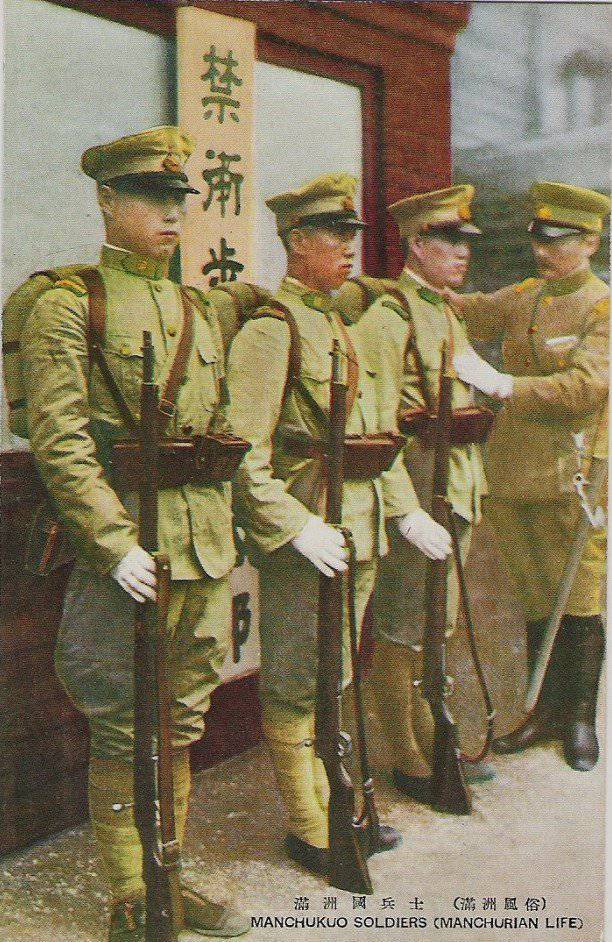
The immediate process of creating the Manchu imperial army was led by Japanese officers from the Kwantung Army. Already in 1933, the number of armed forces of Manchukuu amounted to more than 110 thousands of troops. They were divided into seven military groups stationed in seven provinces of Manzhou-go, cavalry units, the imperial guard. Representatives of all nationalities residing in Manchuria were recruited into the armed forces; however, some units, primarily the Imperial Guard Pu Yi, were staffed exclusively with ethnic Manchus.
It should be noted that the high fighting qualities of the Manchu army did not differ from the outset. This was due to several reasons. First, since the Manchu army became the basis of the surrendered units of the Chinese Northeastern Army, it inherited all the negative features of the latter, including low combat capability, lack of discipline, and poor preparedness. Secondly, many ethnic Chinese served in the Manchu army disloyally disposed towards the Manchu authorities, and especially the Japanese, and who had the slightest chance of deserting, or even going over to the side of the enemy. Third, the real "scourge" of the Manchu armed forces was the smoking of opium, which turned many soldiers and officers into consummate drug addicts. The low fighting qualities of the Manchu army were aggravated by the lack of normally trained officers, which led the imperial government and Japanese advisers to the need to reform the training of the officer corps. In 1934, it was decided to recruit officers of the Manchu imperial army solely at the expense of graduates of the Manchu military schools. For the training of officers in 1938, two Manchu military academies were opened in Mukden and Xinjing.
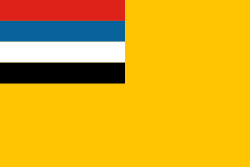 Another serious problem of the Manchu army for a long time remained the lack of a unified uniform. For the most part, soldiers and officers used the old Chinese uniform, which deprived them of their differences from the uniforms of the enemy and led to serious confusion. Only in 1934 was it decided to introduce uniforms based on the uniforms of the Japanese imperial army. 12 May 1937 was approved by the standard of uniforms of the Manchu imperial army on the Japanese model. It imitated the Japanese army in many ways: in the presence of a leather inclined belt and a breast pocket, and in shoulder straps, and in a headdress, and in a pentagram cockade, the rays of which were painted in the colors of the state flag of Manzhou-go (black, white, yellow, blue-green, red). The colors of the branches of arms also copied the Japanese: red meant infantry units, green — cavalry, yellow — artillery, brown — engineering, blue — transport, and black — police.
Another serious problem of the Manchu army for a long time remained the lack of a unified uniform. For the most part, soldiers and officers used the old Chinese uniform, which deprived them of their differences from the uniforms of the enemy and led to serious confusion. Only in 1934 was it decided to introduce uniforms based on the uniforms of the Japanese imperial army. 12 May 1937 was approved by the standard of uniforms of the Manchu imperial army on the Japanese model. It imitated the Japanese army in many ways: in the presence of a leather inclined belt and a breast pocket, and in shoulder straps, and in a headdress, and in a pentagram cockade, the rays of which were painted in the colors of the state flag of Manzhou-go (black, white, yellow, blue-green, red). The colors of the branches of arms also copied the Japanese: red meant infantry units, green — cavalry, yellow — artillery, brown — engineering, blue — transport, and black — police. The following military ranks were established in the Manchu imperial army: Army General, Colonel General, Lieutenant General, Major General, Colonel, Lieutenant Colonel, Major, Captain, First Lieutenant, Lieutenant, First Lieutenant, Warrant Officer, Senior Sergeant, Sergeant, First Sergeant , Acting Junior Sergeant, Private upper class, Private First Class, Private Second Class.
In 1932, the army of Manchuku numbered 111 044 military personnel and included the army of the province of Fengtian (20 541 military personnel, 7 mixed and 2 cavalry brigades); Xing'an Provincial Army (4 374 military); Heilongjiang Provincial Army (strength - 25 162 military, composition - 5 mixed and 3 cavalry brigades); Jilin Provincial Army (strength - 34 287 military, composition - 7 infantry and 2 cavalry brigades). Also in the Manchu army consisted of several separate cavalry brigades and auxiliary units.
In 1934, the structure of the Manchu army was reformed. It consisted of five district armies, each of which included two or three zones with two or three mixed brigades in each. In addition to the zones, the army could include operational forces represented by one to three cavalry brigades. The number of armed forces by this time consisted of 72 329 military personnel. By 1944, the number of the Manchu imperial army was already 200 thousand people, and the composition included several infantry and cavalry division, including 10 infantry, 21 mixed and 6 cavalry brigades. The units of the Manchu army took part jointly with Japanese troops in the suppression of the actions of the Korean and Chinese partisans.
In 1941, Soviet intelligence, which closely monitored the condition of the Japanese troops and their allied forces, reported on the following composition of the Manzhou-Guo armed forces: 21 mixed brigade, 6 infantry brigades, 5 cavalry brigades, 4 separate brigades, 1 guards, guards. 2 cavalry divisions, 1 "division of peace", 9 individual cavalry regiments, 2 individual infantry regiments, 9 training units, 5 anti-aircraft artillery regiments, 3 squadron. Number of soldiers was estimated at 105 710 people, light machine guns - 2039, heavy machine guns - 755, mortars and mortars - 232, 75-mm mountain and field guns - 142, anti-aircraft guns - 176, antitank guns - 56, aircraft - 50 (intelligence reports No. 4 (according to Vostok). M .: RU GSH RKKA, 1941. C. 34).
An interesting page in the history of Manchuku was the participation of Russian white émigrés and their children, who migrated to the territory of Manchuria after the defeat of whites in the Civil War very much, in the military-political activities of the Manchurian state. In the 1942 year, all Russian men before the 35 years were drawn to compulsory military training, and in the 1944 year, the age involved in general military training was raised to 45 years. Every Sunday, Russian emigrants were taught military and fire training, in the summer months a short-term field camp was organized. At the initiative of the Harbin military mission in 1943, Russian military units were created with Russian officers at the head. The first infantry squad was stationed at Handaohedzy station, and the second cavalry detachment was stationed at Sungari 2 station. Russian young men and men were trained in the detachment under the command of colonel Japanese imperial army Asano, later replaced by a Russian officer - emigrant Smirnov.
All servicemen of the cavalry detachment at the Songhua 2-I station were listed as part of the armed forces of Manchukuo, officer ranks were conferred by the Manchu military command. In total, 2 had served in the detachment on the Songhua 4-4,% of thousands of Russian emigrants. Thousands of servicemen were trained at 2 at Handahohedzy Station, where Colonel Popov commanded the detachment. It should be noted that the Russians were considered the fifth nation of Manchukuo and, accordingly, were supposed to carry the full conscription as citizens of this state.
The imperial guard of Manchukuo, completed exclusively by ethnic Manchus and deployed in Xinjin, close to the imperial palace of the head of state Pu I., remained a special elite division of the Manchu army. The Japanese imperial guard became the model for creating the imperial guard of Manchu. Manchurians recruited into the Guard were trained separately from other servicemen. The weapons of the guard were fire and cold. weapon. Guardsmen wore gray and black uniforms, caps and helmets with a five-pointed star on the cockade. The number of guards was just 200 military. In addition to the imperial guard, over time, the guard was given the function of modern special forces. She performed the so-called. Special Guard engaged in counterpartisan operations and the suppression of popular uprisings in the territory of the Manchu proper.
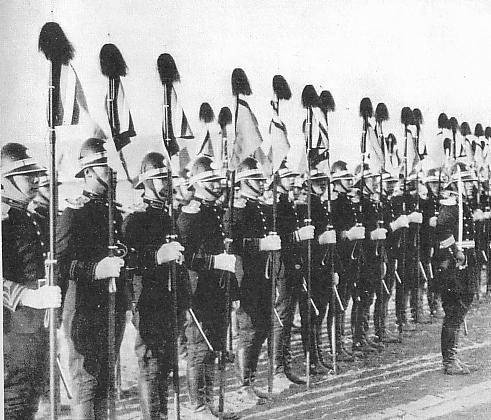
The Manchu imperial army was notable for its weak armament. At the beginning of its history, it was armed with almost 100% captured Chinese weapons, primarily rifles and pistols. By the mid-1930s, the streamlining of the Arsenal of the Manchu armed forces began. First of all, large quantities of firearms arrived from Japan - first 50 cavalry rifles, then machine-gun lots. As a result, the Manchurian army was armed with the machine gun Type-000, machine gun Type-3, mortar Type-11, and rifles Type-10 and Type-38. The officer corps was also armed with Browning and Colt pistols, and the non-commissioned officers were armed with Mausers. As for heavy weapons, the artillery of the Manchu army consisted of Japanese artillery - mountain 39-mm Type-75, field Type-41, as well as captured Chinese artillery. Artillery was the weak side of the Manchu army and in the event of serious clashes the latter would have had to rely solely on the help of the Kwantung. As for armored vehicles, for a long time it was practically absent. Only in 38, the Kwantung Army transferred 1943 Type 10 wedges to the Manchus. As a result, tank company of the Manchu imperial army.
Manchu Sea and Air Fleet
As for the sea fleet, then in this area Manzhou-go also did not differ in serious power. Back in 1932, the Japanese leadership, given that Manzhou had access to the sea, was preoccupied with the problem of creating the Manchu imperial fleet. In February 1932, five military boats were received from Chinese admiral Yin Zu-Qiang, which made up the backbone of the River Guard Fleet patrolling the Sungari River. On April 15, 1932, the Law on the Manzhouli Armed Forces was passed. In accordance with it, the imperial fleet of Manzhou-go was formed. As a flagship, the Japanese handed over to the Manchu the destroyer destroyer Hai Wei. In 1933, a batch of Japanese military boats delivered to protect the Sungari, Amur and Ussuri rivers was delivered. Officers trained at the Imperial Navy Military Academy in Japan. In November 1939, the Manzhou-go River Guard Fleet was officially renamed the Manzhou-go Imperial Fleet. Its command structure consisted partly of Japanese officers, since the Manchus did not have enough naval officers, and it was not always possible to train them at an accelerated pace. In the fighting, the Manchu imperial fleet did not play a serious role and during the Soviet-Japanese war was completely destroyed.
The imperial fleet of Manzhou-yu was structured into the following components: Coast defense forces as part of the Hai Wei destroyer and 4 patrol divisions of combat boats, River defense forces as part of the 1 patrol division of patrol boats, the Imperial Marine Corps as part of two squads for 500 and worn military patrol battalion. armed with machine guns and small arms. Marines were recruited from the Manchus and the Japanese and were used to carry out security service at the naval bases and in the ports.
The creation of the Imperial Air Force of Manzhou-go was also associated with the initiative of the Japanese military command. Back in 1931, the national airline of Manzhou-go was created, which was supposed to be used as a military organization in case of war. Later, 30 people who were trained in Harbin were enrolled in the Imperial Air Force. Three were formed aviation parts. The first is in Changchun, the second is in Fengtian, the third is in Harbin. The aircraft were armed with Japanese aircraft. In 1940, the Imperial Air Force Air Defense Department was established.
Between 1932 and 1940 the manning of the Manchukuo air force was carried out exclusively by Japanese pilots. In 1940, the training of piloting of military aircraft of ethnic Manchus began. In the flight school of Manchuku, both military and civilian pilots were trained. On the balance of the school consisted of twenty educational Japanese aircraft. The imperial court used for its own purposes the air transport of three aircraft. The unpleasant story for the Japanese and Manchu command was connected with the flight school of the Manchu-do Air Force when in January 1941 about 100 the pilots revolted and went over to the Chinese partisans, thus avenging the Japanese for killing their commander and instructor.
The Soviet-Japanese war was met with the command of the 2-th Air Army of the Japanese Air Force as part of the command of the air force of Manzhou The total number of sorties of the Manchu pilots did not exceed 120. The headache of the Manchurian aviation was an insufficient number of aircraft, in particular, adequate to modern conditions. In many ways, this led to the rapid fiasco of the Manchu Air Force. Although they also had heroic pages associated with borrowing air tactics from the Japanese. So, the kamikaze was attacked by an American bomber. Kamikaze tactics were used against Soviet tanks.
End of the Manchu Empire
The state of Manchukuu fell under the blows of the Soviet army, which defeated the Japanese Kwantung Army, as well as other puppet states created by the Axis countries. As a result of the Manchurian operation, 84 was destroyed by thousands of Japanese soldiers and officers, 15 thousand died from wounds and diseases, 600 thousand people were captured. These figures are many times greater than the losses of the Soviet Army, estimated at 12 thousands of troops. Both Japan and its satellites in the territory of present-day China - Manzhou-go and Mengjiang (a state in the territory of present-day Inner Mongolia) suffered a crushing defeat. The personnel of the Manchu armed forces partly perished, partly surrendered. The Japanese settlers who lived in Manchuria were interned.
As for Emperor Pu Yi, with him both the Soviet and Chinese authorities are quite humane. 16 August 1945, the emperor was captured by Soviet troops and sent to a prisoner of war camp in the Khabarovsk region. In 1949, he asked Stalin not to hand him over to the revolutionary Chinese authorities, fearing that the Chinese Communists would sentence him to death. However, he was still deported to China in 1950, and for nine years he was in a re-education camp in Liaoning Province. In 1959, Mao Zedong allowed the release of the "re-educated emperor" and even to settle him in Beijing. Pu Yi got a job at the botanical garden, then worked at the state library, in every way trying to emphasize his loyalty to the new authorities of revolutionary China. In 1964, Pu Yi even became a member of the political advisory council of the PRC. He died in the 1967 year, at the age of sixty-one, from liver cancer. He left the famous book of memoirs, The Last Emperor, in which he writes about that period of fourteen years, during which he occupied the imperial throne in the puppet state of Manchukuo.
Information